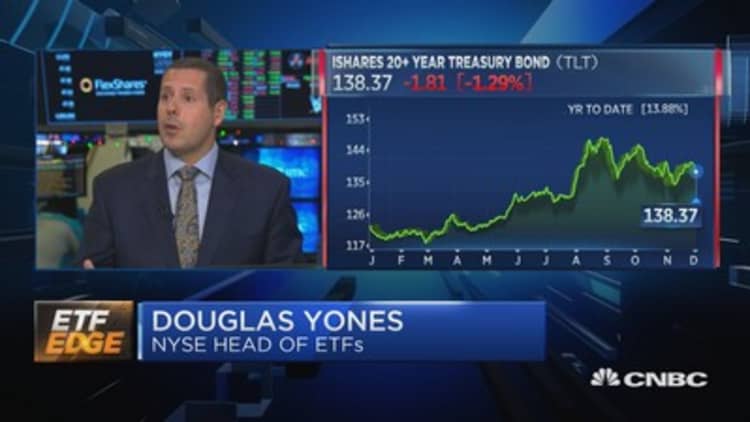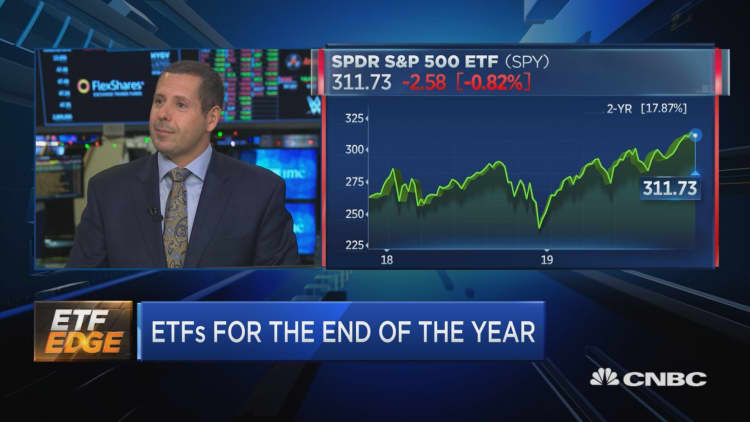
This year, investors are getting their fix in fixed income.
Net cash flows into U.S.-based exchange-traded funds have risen to $271 billion for 2019, putting inflows on track for their second-largest year on record, according to ETF.com.
Just over half is flowing into fixed-income ETFs, a "fascinating" trend that is likely to continue, according to Douglas Yones, head of exchange-traded products for the New York Stock Exchange.
"Net cash flow in ETFs this year [is] $271 billion, but 51% of that into fixed-income ETFs," Yones said Monday on CNBC's "ETF Edge." "So, we continue to see the asset-gathering."
That accumulation adds to the record $4 trillion in U.S. ETF assets under management this year. Much of it has favored high-yielding fixed-income investments as well as international fixed-income plays, Yones said.
Some of the most popular fixed-income ETFs on the market include the iShares Core U.S. Aggregate Bond ETF (AGG), the Vanguard Total Bond Market ETF (BND) and its international counterpart, (BNDX), the iShares iBoxx USD High Yield Corporate Bond ETF (HYG) and the iShares 20+ Year Treasury Bond ETF (TLT). All of them are up modestly year to date.
"High yield's been volatile. We've seen tremendous inflows and then also tremendous outflows throughout the year, but it's also in international," Yones said. "We've seen almost $8 billion this year in international fixed income come in. But the primary movers, I think, have been in the short term."
Yones attributed the short-term moves to investors reversing their assumptions that the Federal Reserve would embark on a rate-hiking cycle, as the central bank suggested it might do late last year. The Fed, however, backed off its rate-hike plans and instead cut interest rates three times over the course of 2019 before apparently deciding to pause indefinitely.
What's interesting about the rush to typically risky high-yield plays is investors' apparent preference for ETFs over mutual funds, Yones said.
Every time high-yield comes back into favor, "it seems like people are choosing an ETF and not necessarily a mutual fund," he said. "We continue to see ETFs provide the exact thing they're supposed to provide: immediate liquidity for those that want access to it, but for those that don't — they want to be a buy-and-hold, long-term investor — the ETF wrapper provides some extra efficiencies. They tend to be a little bit more tax-efficient. They tend to have lower costs."
Andrew McOrmond, managing director of ETF trading solutions at WallachBeth Capital, links the fixed-income dash to market newcomers.
"I attribute it to new users: insurance companies, large institutions putting money into play. It's a dividend. They could trade it. It's easily put on the balance sheet," McOrmond said in the same "ETF Edge" interview.
As for high-yield ETFs, McOrmond said their inherent risk wasn't as amplified this year as it has been in years past.
"They're volatile, but I don't think as overall risky as they might've been a few years back," he said. "We're in a better Fed cycle, much better than last year, so I think that's a big difference."
At the same time, Chris Hempstead, director of institutional business development at IndexIQ, a division of New York Life Investments, found the stock market to be "very healthy right now for equity allocations."
"I think we're going to see that all month long in December," Hempstead said on Monday's show.
For those invested in bond-based funds, Hempstead suggested cementing "your thoughts ... on the shape of the yield curve," the spread between the U.S. 2-Year and 10-Year Treasury yields.
"Despite the fact that we've identified all the different areas where you can invest in fixed income or not invest, you also have to assess what your time horizon looks like. Are you playing the short end of the curve or the long end of the curve?" he said. "The structure of ETFs ... has held up phenomenally well with all of these inflows and even the ones that have had outflows, and there's been quite a few big ETFs that have seen big outflows while others have been the recipients."






